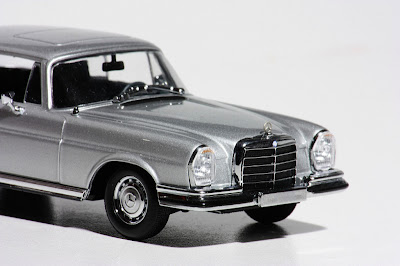Wednesday 28 November 2012
Design of a replacement for the two-door Pontons began in 1957, as most of the chassis and drivetrain were to be unified with the sedan, the scope was focused on the exterior styling. Some of the mockups and prototypes show that Mercedes-Benz attempted to give the two-door car a front styling almost identical to what would be realised in the Pagoda roadster, but ultimately favoured the work of engineer Paul Bracq. The rear bodywork however, persisted, and thus, though officially still called a fintail the rear end design had no chrome fin highlights.
Production began in late 1960, and in February of the next year the coupe was premiered in Stuttgart for the 75th anniversary of the opening of Mercedes-Benz Museum. The convertible followed at the Frankfurt Auto Show a few months later; the car was almost identical to the coupe, with the soft-top roof folded into a recess behind the rear seat and covered by a tightly fitting bag. Unlike the previous generation of two-door ponton series, there was only one model for the 2-door vehicle, the 220SE on both versions, with the identical M127 2195 cc engine. Prices in 1962 were 32,500 for the coupe and 36,000 NLG for the cabriolet. Options included a sliding sunroof for the coupe, automatic transmission, power steering, and individual rear seats.
In March 1962, Mercedes-Benz released the almost identical two-door 300SE. However, due to marketing reasons, this car, like its sedan stablemate, was kept apart from the 220SE, and had its own chassis number W112, which envisioned it as a successor to the W187 300S two-door series, rather than the Ponton range. The car was featured with a chrome strip, air suspension and Daimler's top-range 2996 cm3 M189 engine. For prices of 45,000 and 48,500 for the hard and soft roofs respectively, this vehicle remained split from the rest of the W111 family.
In summer of 1965 Mercedes-Benz launched its new replacements for both W111 and W112 sedans, the W108 and W109 respectively. In a bizarre twist of fate, this car's design was based on the W111 coupe, but widened and squared off, as the fintail fashion was quickly eroding by the mid 1960s. Design work on a future new chassis that would fully replace the Ponton-derivatives which both W111/W112 and W108/W109 were, was well under way (the concept car of the first S-Class was shown in 1967). Given these two facts, Daimler did not develop a W108/W109 two-door vehicle at all and continued production of the W111/W112. However both models were modernised; the 220SE was superseded in early autumn by the 250SE which featured the new 2496 cm3 M129 engine, producing 150 horsepower (110 kW) at 5500 rpm, which gave it a significant improvement in top speed, 193 km/h (120 mph) (188 km/h (117 mph) on auto), and 0–100 km/h acceleration 12 seconds (14 on auto). Visibly the changes only affected the new 14-inch rims with new hub cabs and beauty rings; this was to accommodate the larger disk brakes and the new rear axle from the W108 family.
In November 1967, the 250SE was superseded by the new 280SE. The new M130 engine had 2778 cubic centimetres volume, and output 160 hp (120 kW) at 5500 rpm. Top speed was hardly affected, the acceleration though improved to 10.5 seconds (13 on auto). Inside the car received a wood veneer option on the dashboard and other minor changes including door lock buttons and different heater levers. The hubcaps were changed yet again to a new one piece design and the design of the exterior mirror changed. The 300SE, based on early 1950s M189, was also retired. The modern 280SE could outperform the 300SE despite the smaller engine.
The coupe and cabriolet was back to a single model until its replacement, the new-generation chassis in 1968.
A final model was added in August 1969 the 280SE 3.5. The car was fitted with the brand-new M116 3499 cc V8 engine with 200 hp (150 kW) at 5800 rpm, a top speed of 210 km/h (130 mph) (205 km/h (127 mph) on auto) and a 0-100 at 9,5 seconds (11,5 on auto). To accommodate the large engine, the car's front grille was widened and front and rear bumpers were modified with the addition of rubber strips. The rear lenses changed to a flatter cleaner design. This change was carried across the standard 280SE. Some view this car as an ideological successor to the W112 300SE, though it lacked the air suspension.
There were plans to place the larger M117 V8 engine on the W111 (the model would have been called 280SE 4.5).
The last 280SE was produced in January 1971, with the 280SE 3.5 ending in July. The total production over the decade was: 220SEb - 16,902, 250SE - 6,213, 280SE - 5,187, and 280SE 3.5 - 4,502 units. Not including 3,127 W112 300SE models, the grand total of 2-door W111 models was 32,804 of which 7,456 were convertibles.
The replacement for the 2-doors models was the C107 SLC, focusing on compact sportiness. Moreover for nearly two-decades the convertible would disappear from Mercedes-Benz's lineup altogether (only in 1992 will Daimler launch the A124).
Technical data:
- engine: V8
- capacity: 3500 cc
- horsepower: 200 HP
- gearbox: 3+1
- top speed: 190 km/h











Brak komentarzy:
Prześlij komentarz